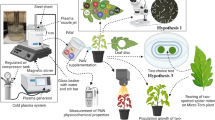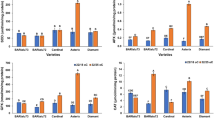Abstract
Low temperature stress is a current challenge to plants that is associated with climate change. In plants, exposure to extreme temperatures is followed by the accumulation of reactive oxygen species, such as hydrogen peroxide (H2O2), leading to oxidative stress. Salicylic acid (SA) and H2O2 mediate the tolerance responses to stress and have been reported to induce freezing tolerance in potato microplants. The objectives of the present investigation were (1) to evaluate the short- and long-term effects of H2O2 and SA treatments on freezing tolerance in potato (Solanum tuberosum L.) plants grown from tubers and (2) to analyse the relationship between catalase (CAT) activity and H2O2 concentration associated with freezing tolerance responses. We observed the lowest freezing survival rates in 45-day-old potato plants (cv. Granate) compared to younger plants. The two treatments consisted of (1) the tuber-dip (long-term) treatment in which sprouted minitubers were saturated for 1 h in SA 10−5 M or H2O2 1 mM and planted in soil under greenhouse conditions and (2) the crop-spray (short-term) treatment in which plants 5–8 cm high were sprayed twice a week with SA 10−5 M or H2O2 1 mM until 45 days of age. In all treatments, 45-day-old plants were then exposed to − 6 ± 1 °C for 4 h. The survival rate was measured 15 days after freezing. CAT and H2O2 measurements were performed 1 h before and after the freezing treatment. The results showed that SA and H2O2 induced freezing tolerance in both the short- and long-term treatments. Survival was significantly higher in SA- and H2O2-treated plants than in control plants. In both the long- and short-term treatments this higher survival was associated with lower internal H2O2 concentrations after freezing compared with control plants and decreasing oxidative stress. SA and H2O2 induced different levels of CAT activity after freezing compared to that found in the control plants in the long- and the short-term treatments. These results suggest the SA and H2O2 function in independent pathways in terms of their induction of freezing tolerance that depends on the method the treatment was applied, by spraying the canopy or by immersion of the sprouted seed tuber.



Similar content being viewed by others
References
Aebi H (1984) Catalase in vitro. Methods Enzymol 105:121–126
Aguilar-Camacho M, Mora-Herrera ME, López-Delgado HA (2016) Potato virus X (PVX) elimination as short and long term effects of hydrogen peroxide and salicylic acid is differentially mediated by oxidative stress in synergism with thermotherapy. Am J Potato Res. https://doi.org/10.1007/s12230-0169509-5
Ahmad I, Basra SMA, Hussain S, Hussain SA, Rehman HU, Rehman A, Ali A (2015) Priming with ascorbic acid, salicylic acid and hydrogen peroxide improves seedling growth of spring maize at suboptimal temperature. J Environ Agric Sci 3:14–22
Apel K, Hirt H (2004) Reactive oxygen species: metabolism, oxidative stress, and signal transduction. Annu Rev Plant Biol 55:373–399
Blokhina O, Virolainen E, Fagerstedt K (2003) Antioxidants, oxidative damage and oxygen deprivation stress: a review. Ann Bot 91:179–194
Chao YY, Chen CY, Huang WD, Kao CH (2010) Salicylic acid-mediated hydrogen peroxide accumulation and protection against cd toxicity in rice leaves. Plant Soil 329:327–337
Chen Z, Silva H, Klessig DF (1993) Active oxygen species in the induction of plant systemic acquired resistance by salicylic acid. Science 262:1883–1886
Daneshmand F, Arvin MJ, Kalantari KM (2009) Effect of acetylsalicylic acid (aspirin) on salt and osmotic stress tolerance in Solanum bulbocastanum in vitro: enzymatic antioxidants. American-Eurasian J Agric Environ Sci 6(1):92–99
Distelbarth H, Nägele T, Heyer AG (2013) Responses of antioxidant enzymes to cold and high light are not correlated to freezing tolerance in natural accessions of Arabidopsis thaliana. Plant Biol 15(6):982–990
Duncan DB (1955) Multiple range and multiple F tests. Biometrics 11:1–42
Fryer MJ, Andrews JR, Oxborough K, Blowers DA, Baker NR (1998) Relationships between CO2 assimilation, photosynthetic electron transport and active O2 metabolism in leaves of maize in the field during periods of low temperature. Plant Physiol 116:571–580
Ganesan V, Thomas G (2001) Salicylic acid response in rice: influence of salicylic acid on H2O2 accumulation and oxidative stress. Plant Sci 160:1095–1106
Hara M, Furukawa J, Sato A, Mizoguchi T, Miura K (2012) Abiotic stress and role of salicylic acid in plants. In: Parvaiza A, Prasad MNV (eds) Abiotic stress responses in plants. Springer, New York, pp 235–251
Hasanuzzaman M, Hossain MA, Teixeira da Silva JA, Fujita M (2012) Plant responses and tolerance to abiotic oxidative stress: antioxidant defenses is a key factors. In: Bandi V, Shanker AK, Shanker C, Mandapaka M (eds) Crop stress and its management: perspectives and strategies. Springer, Berlin, pp 261–316
Hashempour A, Ghasemnezhad M, Ghazvini RF, Sohani MM (2014) Olive (Olea europaea L.) freezing tolerance related to antioxidant enzymes activity during cold acclimation and nonacclimation. Acta Physiol Plant 36:3231–3241
Janda T, Szalai G, Tari I, Paldi E (1999) Hydroponic treatment with salicylic acid decreases the effects of chilling injury in maize (Zea mays L.) plants. Planta 208:175–180
Kang HM, Saltveit ME (2002) Chilling tolerance of maize, cucumber and rice seedling leaves and roots are differentially affected by salicylic acid. Physiol Plant 115:571–576
Kosova K, Prasil IT, Vitamvas P, Dobrev P, Motyka V, Flokova K, Novak O, Turecková V, Rolcik J, Pesek B, Travnickova A, Gaudinova A, Galiba G, Janda T, Vlasakova E, Prasilova P, Vankova R (2012) Complex phytohormone responses during the cold acclimation of two wheat cultivars differing in cold tolerance, winter Samanta and spring Sandra. J Plant Physiol 169:567–576
Kumar M, Sirhindi G, Bhardwaj R, Kumar S. Jain (2010). Effect of exogenous H2O2 on antioxidant enzymes Brassica juncea L. seedlings in relation to 24-epibrassinolide under chilling stress. Ind J Biochem Biophysics 47: 378–382
López-Delgado H, Scott IM (1997) Induction of in vitro tuberization of potato microplants by acetylsalicylic acid. J Plant Physiol 151:74–78
López-Delgado H, Dat JF, Foyer CH, Scott IM (1998) Induction of thermotolerance in potato microplants by acetylsalicylic acid and H2O2. J Exp Bot 49:713–720
López-Delgado H, Mora-Herrera ME, Zavaleta-Mancera HA, Cadena-Hinojosa M, Scott IM (2004) Salicylic acid enhances heat tolerance and potato virus X (PVX) elimination during thermotherapy of potato microplants. Am J Potato Res 81:171–176
López-Delgado HA, Sánchez-Rojo S, Mora-Herrera ME, Martínez-Gutiérrez R (2012) Micro-tuberization as a long term effect of hydrogen peroxide on potato plants. Am J Potato Res 89:240–244
Luo YL, Su ZL, Bi TJ, Cui XL, Lan QY (2014) Salicylic acid improves chilling tolerance by affecting antioxidant enzymes and osmoregulators in sacha inchi (Plukenetia volubilis). Braz J Bot 37(3):357–363
Martínez-Gutiérrez R, Mora-Herrera ME, López-Delgado H (2012) Exogenous H2O2 in Phytoplasma-infected potato plants promotes antioxidant activity and tuber production under drought conditions. Am J Potato Res 89(1):53–62
Miura K, Tada Y (2014) Regulation of water, salinity, and cold stress responses by salicylic acid. Front Physiol 5:4. https://doi.org/10.3389/fpls.2014.00004
Mora-Herrera ME, López-Delgado H (2006) Tolerancia a baja temperatura inducida por ácido salicílico y peróxido de hidrógeno en microplantas de papa. Rev Fitotec Mex 29(2):81–85
Mora-Herrera ME, López-Delgado H, Castillo-Morales A, Foyer CH (2005) Salicylic acid and H2O2 function by independent pathways in the induction of freezing tolerance in potato. Physiol Plant 125:430–440
Mutlu S, Karadağoğlu Ö, Atici Ö, Taşğin E, Nalbantoğlu B (2013) Time-dependent effect of salicylic acid on alleviating cold damage in two barley cultivars differing in cold tolerance. Turk J Bot 37:343–349
Pál M, Szalai G, Kovács V, Gondor OK, Janda T (2013) Salicylic acid-mediated abiotic stress tolerance. In: Hayat S, Ahmad A, Alyemeni MN (eds) Salicylic acid. Plant growth and development. Springer, New York, pp 183–247
Rao MV, Paliyath G, Ormrod DP, Murr DP, Watkins CB (1997) Influence of salicylic acid on H2O2 production, oxidative stress, and H2O2–metabolizing enzymes. Plant Physiol 115:137–149
Rivas-San Vicente M, Plasencia J (2011) Salicylic acid beyond defense: its role in plant growth and development. J Exp Bot 62(10):3321–3338
Salwa AO, Mona GD, Salman SR (2015) Comparative study between the physiological role of hydrogen peroxide and salicylic acid in alleviating the harmful effect of low temperature on tomato plants grown under sand-ponic culture. Sci Agric 9(1):49–59
Sanghera GS, Wani SH, Hussain W, Singh NB (2011) Engineering cold stress tolerance in crop plants. Curr Genomics 12:30–43
Scott IM, Clarke SM, Wood JE, Mur LA (2004) Salicylate accumulation inhibits growth at chilling temperature in Arabidopsis. Plant Physiol 135(2):1040–1049
Shah F, Huang J, Cu K, Nie L, Shah T, Chen C, Wang K (2011) Impact of high temperature stress on rice plant and its traits related to tolerance. J Agri Sci 149:545–556
Upadhyaya H, Khan MH, Panda SK (2007) Hydrogen peroxide induces oxidative stress in detached leaves of Oryza sativa L. Gen App Plant Physiol 33:83–95
Wan SB, Tian L, Tian RR, Pan QH, Zhan JC, Wen PF, Chen JY, Zhang P, Wang W, Huang WD (2009) Involvement of phospholipase D in the low temperature acclimation-induced thermotolerance in grape berry. Plant Physiol Biochem 47:504–510
Warm E, Laties GG (1982) Quantification of hydrogen peroxide in plant extracts by the chemiluminescence reaction with luminol. Phytochemistry 21:827–831
Watanabe T, Kume T (2009) A general adaptation strategy for climate change impacts on paddy cultivation: special reference to the Japanese context. Paddy Water Environ 7:313–320
Xin Z, Browse J (2000) Cold comfort farm: the acclimation of plants to freezing temperatures. Plant Cell Environ 23:893–902
Yordanova R, Popova (2007) Effect of exogenous treatment with salicylic acid on photosynthetic activity and antioxidant capacity of chilled wheat plants. Gen Appl Plant Physiol 33(3–4):155–170
Zhang Y, Luo Y, Hou YX, Jiang H, Chen Q, Tang RH (2008) Chilling acclimation induced changes in the distribution of H2O2 and antioxidant system of strawberry leaves. Agric J 3(4):286–291
Acknowledgements
This research was supported by a grant from Recursos Fiscales, INIFAP (Grant number 13572320889).
Author information
Authors and Affiliations
Corresponding author
Rights and permissions
About this article
Cite this article
López-Delgado, H.A., Martínez-Gutiérrez, R., Mora-Herrera, M.E. et al. Induction of Freezing Tolerance by the Application of Hydrogen Peroxide and Salicylic Acid as Tuber-Dip or Canopy Spraying in Solanum tuberosum L. Plants. Potato Res. 61, 195–206 (2018). https://doi.org/10.1007/s11540-018-9368-1
Received:
Accepted:
Published:
Issue Date:
DOI: https://doi.org/10.1007/s11540-018-9368-1




